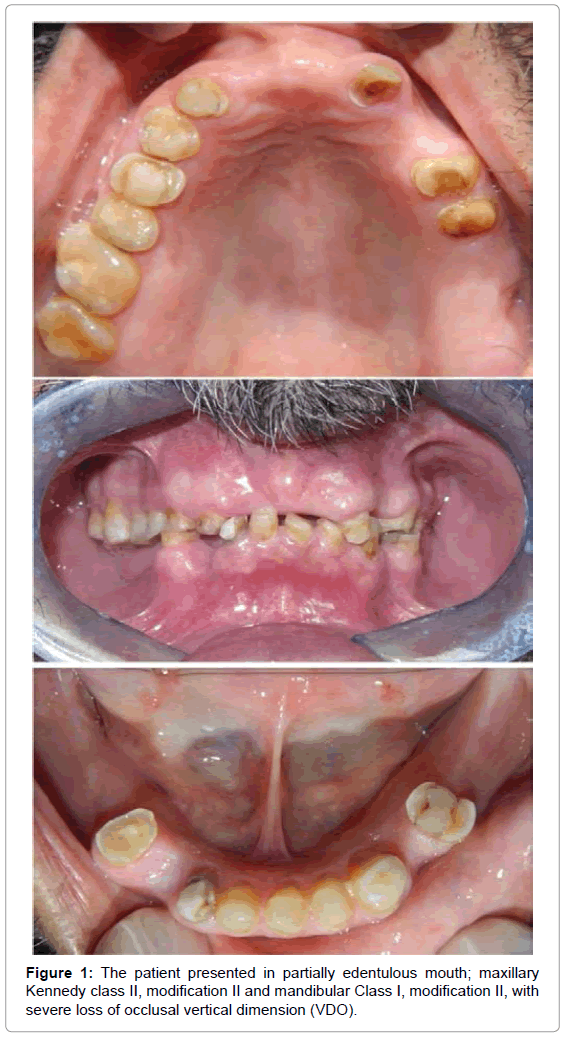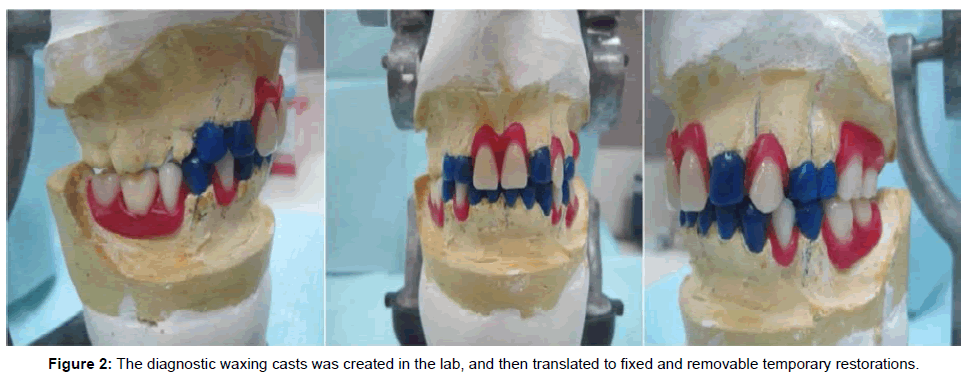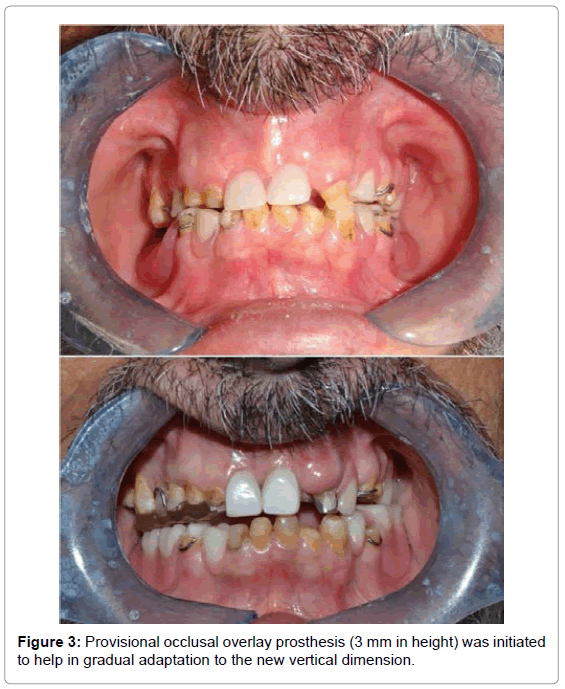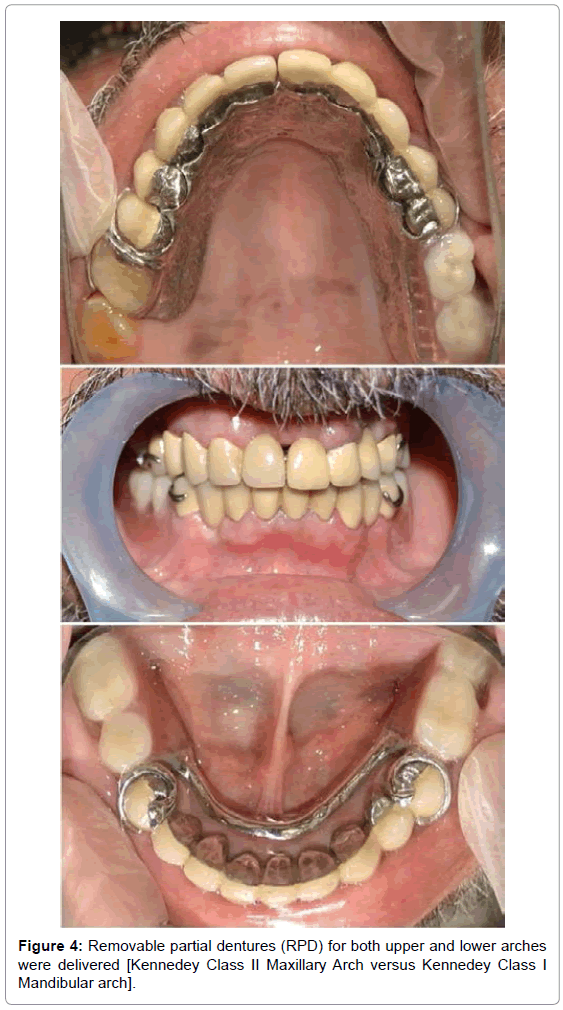Case Report Open Access
Dental Considerations in the Adjustment of Lost Occlusal Vertical Dimension: A Clinical Report
Rayan M Sharka1 and Hassan H Abed2*
1Department of Oral and Maxillofacial Surgery and Diagnostic Sciences, Division of Removable Prosthodontics, School of Dentistry, Umm-Alqura University, Mecca city, Kingdom of Saudi Arabia
2Department of Basic Oral and Clinical Sciences, Division of Oral Diagnostic Medicine, School of Dentistry, Umm-Alqura University, Mecca city, Kingdom of Saudi Arabia
- *Corresponding Author:
- Hassan H Abed
School of Dentistry
Umm-Alqura University
Mecca city, Kingdom of Saudi Arabia
Tel: 0966598023157
E-mail: dr.hassanabed@yahoo.com
Received Date: April 04, 2014; Accepted Date: June 23, 2014; Published Date: June 28, 2014
Citation: Sharka RM, Abed HH (2014) Dental Considerations in the Adjustment of Lost Occlusal Vertical Dimension: A Clinical Report. J Oral Hyg Health 2:140. doi:10.4172/2332-0702.1000140
Copyright: © 2014 Sharka RM, et al. This is an open-access article distributed under the terms of the Creative Commons Attribution License, which permits unrestricted use, distribution, and reproduction in any medium, provided the original author and source are credited.
Visit for more related articles at Journal of Oral Hygiene & Health
Abstract
The purpose of this clinical report is to discuss the clinical considerations related to increasing the occlusal vertical dimension (OVD) when restoring a patient’s dentition. Extra-oral and intraoral evaluations are mandatory to assess the suitability of increasing OVD. In the literature, multiple techniques have been proposed to quantify OVD loss. However, the techniques lack consistency and reliability, which in turn affects the decision of whether to increase the OVD. Therefore, increasing OVD should be determined on the basis of the dental restorative needs and aesthetic demands. In general, a minimal increase in OVD should be applied, through a 5 mm maximum increase in OVD can be justified to provide adequate occlusal space for the restorative material and to improve anterior teeth aesthetics. The literature reflects the safety of increasing the OVD permanently, and although signs and symptoms may develop, these are usually of an interim nature. The exception to this is for patients with Temporo-mandibular joint disorder (TMD), where increasing the OVD should still be achieved using removable appliances to control TMDassociated symptoms before considering any form of irreversible procedures.
Keywords
Fixed partial denture; Removable partial denture; Overlay prosthesis; Cantilever; Occlusal vertical dimension
Introduction
Rehabilitation of lost occlusal vertical dimension with multiple missing teeth by fixed and removable prosthesis is a complex procedure even with experts’ dentists. However, dentists with high quality of skills and up dated knowledge can create excellent occlusion rehabilitation with fixed and removable dentures. This is lead to healthy dentition and acceptable esthetic zone [1]. Rehabilitation with fixed prosthesis for multiple missing teeth is not easy, like single tooth missing procedures [2]. Nowadays, implant becomes a master key for various treatment plan and positive satisfaction of the patient. Unfortunately, this kind of solution could be impossible because of financial issues. Actually, Removable and fixed partial denture still a conventional and simple way to be an essential prosthetic consideration in much oral rehabilitation[3].
History and Chief Complaint
A 62 year old male patient presents to King Abdul-Aziz University Faculty of Dentistry (KAUFD) Pre-doctoral Clinics for general comprehensive care clinic. Patient’s chief concern was to be able to regain proper function at lowest cost and with particular esthetic concern. The patient’s medical history was free from any medical diseases and has no contraindications to dental treatment. The patient presented in partially edentulous state; maxillary Kennedy class II, modification II and mandibular Class I, modification II, with severe loss of occlusal vertical dimension (VDO) (Figure 1). He came to KAUFD with previously restored maxillary teeth at his existing VDO. While mandibular anterior teeth had been with sever attrition. Dimensional vertical occlusion examination was done by using interocclusal space, phonetic methods, Willis method and Pound’s specifications with attention given to facial appearance [4-6]. Vertical dimension of occlusion measurement result was: 62 mm, in rest position was 71 mm. The measurement result showed loss of vertical dimension. Based on the estimation, rest position occlusionwas 71-62 mm=9 mm, then subtracted by freeway space and the result was 9-4 mm=5 mm.
Diagnosis and Treatment Planning
A semi-adjustable articulator with facebow and mounted diagnostic casts were recorded in a centric relation position. Treatment options explained to patient in the following order: First option, for both maxillary and mandibular arches implant placement is a key master with removable partial denture (RPDs) and fixed crowns to appropriate VDO. Second option, for both maxillary and mandibular arches removable and fixed partial dentures without implant placement to appropriate VDO. Unfortunately, first option was very difficult through patient to tolerate the financial issue of implant placement. On the other hand, second option was accepted to the patient in concern that was not the perfect treatment and this may reflected to esthetic zone of his smile. Also, he was informed that his treatment will need a lot of time to camouflage his existing VDO and this will extract through interim occlusal overlay prosthesis, which would be required for at least 7 to 8 weeks before definitive prosthodontic treatment deliver to be sure that new creating VDO is suitable for him without any complication to Temporo-mandibular joint(TMJ). Consent form was obtained from the patient about the judgious of his choose and treatment plan.
Case Management
The main Goals of the treatment plan were to: [1] Create an ideal occlusal plane at the level of both maxilla and mandible; [2] Restoration by mean of correction the vertical dimension; [3] create static occlusal contacts in centric occlusion concurrent with centric relation; [4] initiation of suitable anterior guidance; and [5] reach to the acceptable face appearance through esthetics ways. The diagnostic waxing casts was created and completed in the dental labs and translated to fixed and removable temporary restorations (Figure 2). Both arches were initiated simultaneously to create balanced occlusion. Provisional occlusal overlay prosthesis (3 mm in height) was initiated to help in gradual adaptation to the new vertical dimension (Figure 3). The created prosthesis was constructed according to the first clinical remaining teeth structures of the patient dentition and occlusion. Artificial prosthesis such as removable partial denture was constructed to fill the edentulous area. Intentional endodontic root canal treatments for Upper Maxillary teeth with all mandibularremaining teeth were established. After 5 weeks of using the previous interim dentures, the vertical dimension was measured by using the first method. However, 2 mm was increased in the height at final desired treated prostheses (upper overlay partial denture and the mandibular interim acrylic partial denture). Composite build up with fiber posts were created for the following teeth (# 13, 35, 33, 32, 31, 41 and 44). Casted post & Core was constructed on teeth # 22. Crowns (porcelain with metal, PFM) was created and cemented on teeth #14 and #15. Splinted crowns on teeth # 13 with #12 and Cantilever #11. On the same way for the upper left quadrant, Splinted crowns on teeth # 25, 24&22 with Cantilever #21.PFM crowns on teeth # 35,33,32,31,41,42,44. Surveyed Crownwas constructed on teeth # 15, 24, 25, 35, 44. Removable partial dentures (RPD) for both upper and lower arches were delivered [Kennedey Class II Maxillary Arch versus Kennedey Class I Mandibular arch] (Figure 4). The Long term prognosis of the whole dentures and crowns would depend on Oral hygiene instructions and maintenance [7]. A routine follow up after one day, one week, one month, and finally six months. The patient was very excited and comfortable with both fixed and removable prostheses. No any Temporo-mandibular joint disorder (TMD) was reported.
Discussion
Lost vertical dimension is a common problem seen in the dental clinics. These conditions are often associated with a multiple missing teeth. This case declares the using of overlay removable partial denture to rehabilitate the mouth of the patient [8-11]. Follow up after six months with this case reveal neither symptoms nor any TMD complication. The patient was satisfied with this treatment in both esthetic and functioning way. Longest time was during the primary phase of increasing the OVD. The justification behind this duration is to help neuromuscular system to adaptive with new VDO. Overlay prosthesis was recommended for 6 to 8 weeks adaptation period for final fixed prosthesis in similar situations as well [12]. In our case, after eight weeks of interim prostheses, we use the same concept of increasing the OVD. However, during try-in visit we detected that VDO could be increased and the patient reported no muscle or any TMD. This kind of treatment plan was not aggressive and without implants. Treatment costs were significantly less than all other options to restore complex dentition. Esthetic and functional limitations between treatment plan with implants and other with removable and fixed denture without implants were discussed with the patient to avoid any compliant in the future. Failure could be range between wearing, deboning and fracture of the denture. Routinely maintenance visits are potentially very important to encourage the long term success of treatment. However, oral hygiene instructions and denture hygiene should be reinforced to the patient every visit to ensure the longevity of the treatment.
Conclusion
Full-mouth rehabilitation based on the most current evidence will help to assure a favorable long term outcome. On contrast, financial issue can alter the treatment plan of many patients. However, proper management with comprehensive team of prosthodontists (removable and fixed), endodontist and restorative dentists can achieve the most predictable treatment outcome resulted in a successful treatment through fixed and removable partial dentures with respect that most of the patients cannot offer the implants either financially or due to any systemic diseases that avert such treatment [13-15].
References
- Budtz-Jörgensen E (1996) Restoration of the partially edentulous mouth - a comparison of overdentures, removable partial dentures, fixed partial dentures andimplant treatment. J Dent 24:237-244.
- Scurria MS, Bader JD, Shugars DA (1998) Meta-analysis offixed partial denture survival: Prostheses and abutments. J Prosthet Dent 79:459-464.
- Mazurat NM, Mazurat RD (2003) Discuss before fabricating: communicating the realities of partial denture therapy. Part I: Patient expectations. J Can Dent Assoc69:90-94.
- Pound E (1966)The mandibular movements of speech and their seven related values. J Prosthet Dent 16:835-843.
- Pound E (1950)Aesthetics and phonetics in full denture construction. Aust J Dent 54:322-327.
- Turrell AJ (1972) Clinical assessment of vertical dimension. J Prosthet Dent 96:79-83.
- Featherstone JD, Adair SM, Anderson MH (2001) Caries management by risk assessment: consensus statement. J CalifDent Assoc31:257-269.
- Gankerseer EJ (1987) Case report: a new technique for the treatment of the severely worn dentition. Restorative Dent 3:13–14.
- Lee H, Oster C (2006) A technique to fabricate metal occlusal surfaces for the overlay removable partial denture. J Prosthet Dent 96:456-457.
- Guttal S, Narendra PP (2005) Cast titanium overlay denture for a geriatric patient with a reduced vertical dimension. Gerodontolgy22:242-245.
- Chu FC, Siu AS, Newsome PR, Chow TW, Smales RJ (2002) Restorative management of the worn dentition.4 Generalized tooth wear. Dent Update 29:318-324.
- Turner KA, Missirlian DM (1984) Restoration of the extremely worn dentition. J Prosthet Dent 52:467-474.
- Torabinejad M, Anderson P, Bader J (2007) Outcomes of root canal treatment and restoration, implant-supported single crowns, fixed partial dentures, and extraction without replacement: a systematic review. J Prosthet Dent 98:285-311.
- Salinas T, Eckert S (2012) Implant-supported single crowns predictably survive to five years with limited complications. J Evid Based Dent Pract12:213-214.
- Alqahtani F (2014) Full-Mouth Rehabilitation of severely Worn Dentition Due to Soda Swishing: A Clinical Report. J Prostho23: 50-57.
Relevant Topics
- Advanced Bleeding Gums
- Advanced Receeding Gums
- Bleeding Gums
- Children’s Oral Health
- Coronal Fracture
- Dental Anestheia and Sedation
- Dental Plaque
- Dental Radiology
- Dentistry and Diabetes
- Fluoride Treatments
- Gum Cancer
- Gum Infection
- Occlusal Splint
- Oral and Maxillofacial Pathology
- Oral Hygiene
- Oral Hygiene Blogs
- Oral Hygiene Case Reports
- Oral Hygiene Practice
- Oral Leukoplakia
- Oral Microbiome
- Oral Rehydration
- Oral Surgery Special Issue
- Orthodontistry
- Periodontal Disease Management
- Periodontistry
- Root Canal Treatment
- Tele-Dentistry
Recommended Journals
Article Tools
Article Usage
- Total views: 24224
- [From(publication date):
September-2014 - Nov 21, 2024] - Breakdown by view type
- HTML page views : 19095
- PDF downloads : 5129




